window MITSUBISHI MIRAGE G4 2020 Owner's Manual (in English)
[x] Cancel search | Manufacturer: MITSUBISHI, Model Year: 2020, Model line: MIRAGE G4, Model: MITSUBISHI MIRAGE G4 2020Pages: 253, PDF Size: 36.39 MB
Page 6 of 253
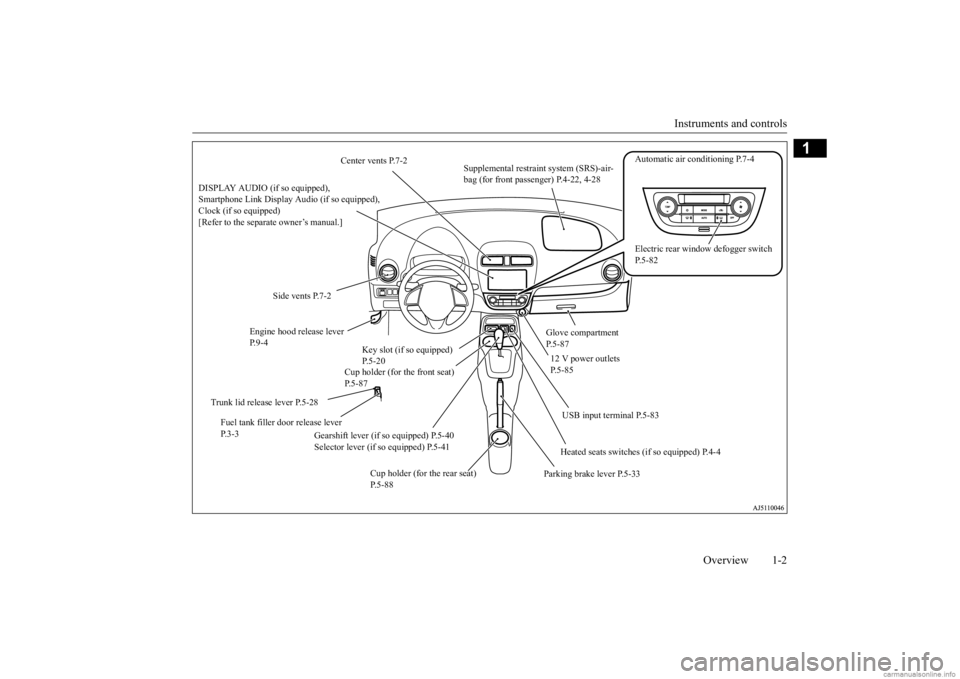
Instruments and controls
Overview 1-2
1
Center vents P.7-2
Supplemental restraint system (SRS)-air- bag (for front passenger) P.4-22, 4-28
Automatic air conditioning P.7-4
Side vents P.7-2
Glove compartment P.5-87
Engine hood release lever P. 9 - 4
Cup holder (for the front seat) P.5-87
12 V power outlets P.5-85
Electric rear window defogger switch P.5-82
Key slot (if so equipped) P.5-20
Gearshift lever (if so equipped) P.5-40 Selector lever (if so equipped) P.5-41
Fuel tank filler door release lever P. 3 - 3
Parking brake lever P.5-33
Cup holder (for the rear seat) P.5-88
DISPLAY AUDIO (if so equipped), Smartphone Link Display Audio (if so equipped), Clock (if so equipped)[Refer to the separate owner’s manual.]
USB input terminal P.5-83 Heated seats switches (if so equipped) P.4-4
Trunk lid release lever P.5-28
BK0284300US.book 2 ページ 2019年5月23日 木曜日 午後12時22分
Page 7 of 253
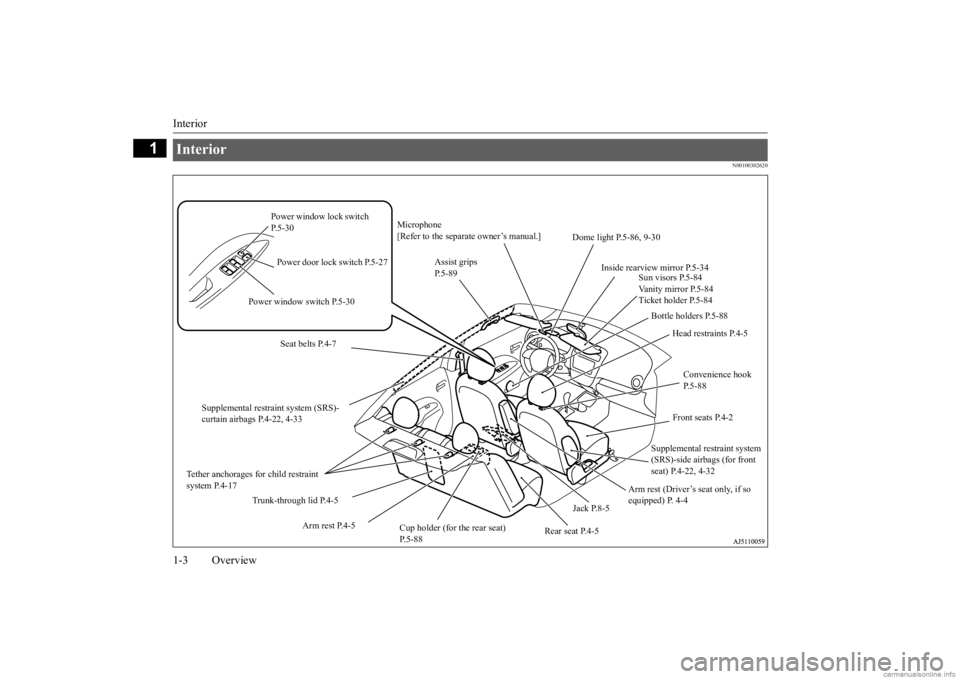
Interior 1-3 Overview
1
N00100302620
Interior
Bottle holders P.5-88
Power window lock switch P.5-30
Sun visors P.5-84 Vanity mirror P.5-84 Ticket holder P.5-84
Power door lock switch P.5-27
Dome light P.5-86, 9-30
Inside rearview mirror P.5-34
Head restraints P.4-5
Power window switch P.5-30
Seat belts P.4-7
Supplemental restraint system (SRS)- curtain airbags P.4-22, 4-33
Tether anchorages for child restraint system P.4-17
Front seats P.4-2
Supplemental restraint system (SRS)-side airbags (for front seat) P.4-22, 4-32
Arm rest P.4-5
Jack P.8-5
Rear seat P.4-5
Cup holder (for the rear seat) P.5-88
Assist grips P.5-89
Arm rest (Driver’s seat only, if so equipped) P. 4-4
Microphone [Refer to the separate owner’s manual.]
Trunk-through lid P.4-5
Convenience hook P.5-88
BK0284300US.book 3 ページ 2019年5月23日 木曜日 午後12時22分
Page 9 of 253
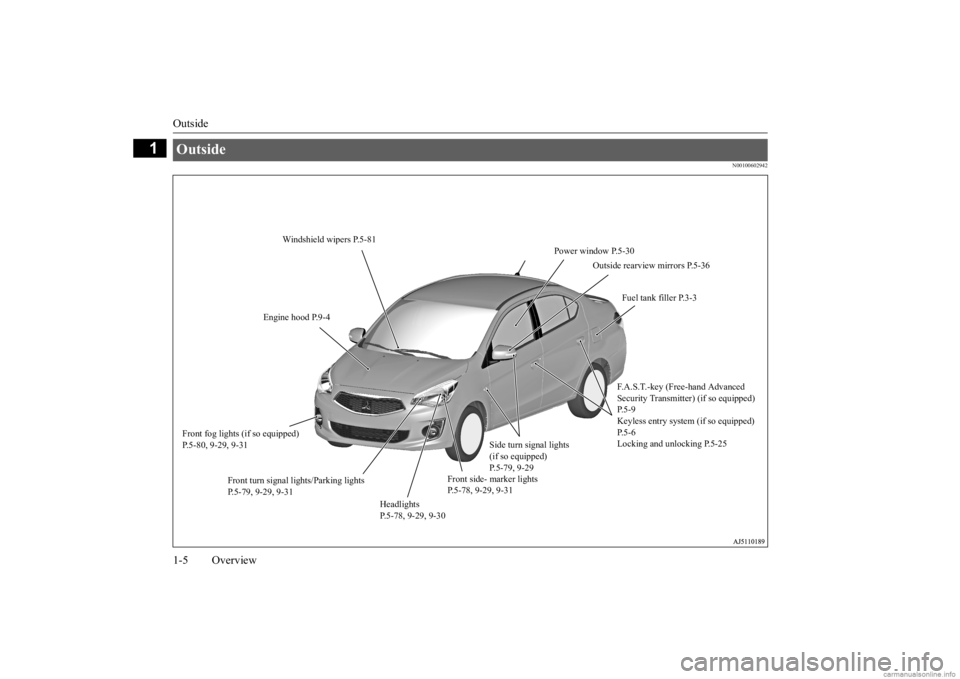
Outside 1-5 Overview
1
N00100602942
Outside
Power window P.5-30
Windshield wipers P.5-81
Outside rearview mirrors P.5-36
Fuel tank filler P.3-3
Engine hood P.9-4
F.A.S.T.-key (Free-hand Advanced Security Transmitter) (if so equipped) P. 5 - 9 Keyless entry system (if so equipped) P. 5 - 6 Locking and unlocking P.5-25
Side turn signal lights (if so equipped)P.5-79, 9-29
Front side- marker lights P.5-78, 9-29, 9-31
Front fog lights (if so equipped) P.5-80, 9-29, 9-31
Front turn signal lights/Parking lights P.5-79, 9-29, 9-31
Headlights P.5-78, 9-29, 9-30
BK0284300US.book 5 ページ 2019年5月23日 木曜日 午後12時22分
Page 17 of 253
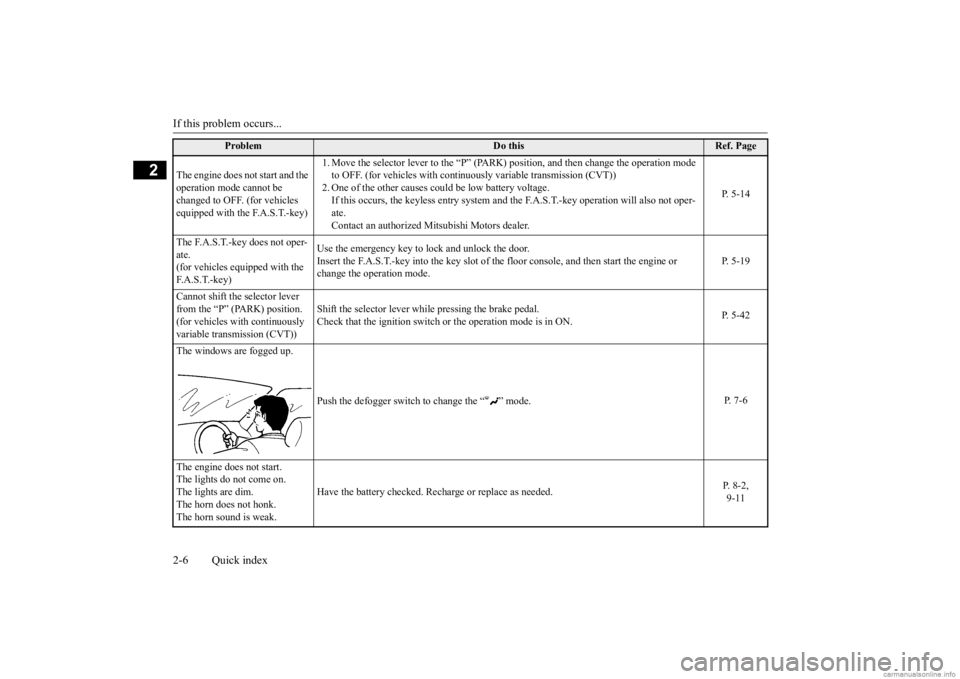
If this problem occurs... 2-6 Quick index
2
The engine does not start and the operation mode cannot be changed to OFF. (for vehicles equipped with the F.A.S.T.-key)
1. Move the selector le
ver to the “P” (PARK) position, a
nd then change the operation mode
to OFF. (for vehicles with conti
nuously variable transmission (CVT))
2. One of the other causes c
ould be low battery voltage.
If this occurs, the keyless entr
y system and the F.A.S.T.-key
operation will also not oper-
ate.Contact an authorized Mitsubishi Motors dealer.
P. 5-14
The F.A.S.T.-key does not oper- ate.(for vehicles equipped with the F. A . S . T. - k e y )
Use the emergency key to lock and unlock the door. Insert the F.A.S.T.-key into the key slot of th
e floor console, and then start the engine or
change the operation mode.
P. 5-19
Cannot shift the selector lever from the “P” (PARK) position. (for vehicles with continuously variable transmission (CVT))
Shift the selector lever while pressing the brake pedal. Check that the ignition switch
or the operation mode is in ON.
P. 5-42
The windows are fogged up.
Push the defogger switch
to change the “ ” mode.
P. 7-6
The engine does not start. The lights do not come on.The lights are dim. The horn does not honk. The horn sound is weak.
Have the battery checked. Rech
arge or replace as needed.
P. 8-2, 9-11
Problem
Do this
Ref. Page
BK0284300US.book 6 ページ 2019年5月23日 木曜日 午後12時22分
Page 50 of 253
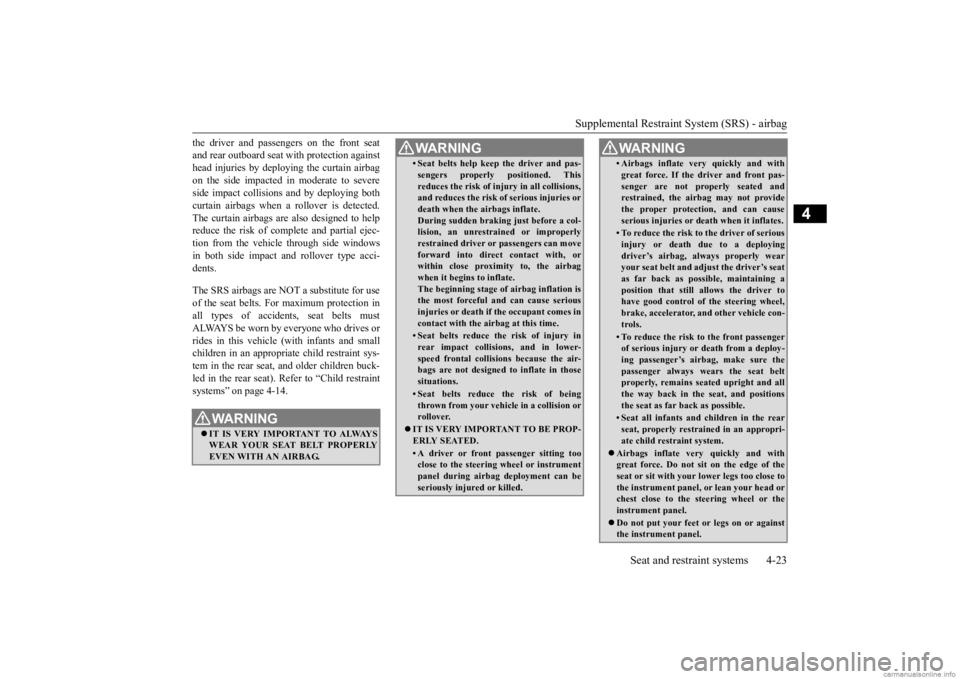
Supplemental Restraint System (SRS) - airbag
Seat and restraint systems 4-23
4
the driver and passengers on the front seat and rear outboard seat
with protection against
head injuries by deploying the curtain airbag on the side impacted
in moderate to severe
side impact collisions
and by deploying both
curtain airbags when a rollover is detected. The curtain airbags are also designed to help reduce the risk of comp
lete and partial ejec-
tion from the vehicle through side windows in both side impact a
nd rollover type acci-
dents. The SRS airbags are NOT a substitute for use of the seat belts. For maximum protection in all types of accidents, seat belts mustALWAYS be worn by everyone who drives or rides in this vehicle
(with infants and small
children in an appropriate child restraint sys-tem in the rear seat, and older children buck- led in the rear seat). Refer to “Child restraint systems” on page 4-14.
WA R N I N G IT IS VERY IMPORTANT TO ALWAYS WEAR YOUR SEAT BELT PROPERLY EVEN WITH AN AIRBAG.
• Seat belts help keep the driver and pas-sengers properly positioned. Thisreduces the risk of injury in all collisions,and reduces the risk of serious injuries or death when the airbags inflate. During sudden braking just before a col-lision, an unrestra
ined or improperly
restrained driver or passengers can move forward into direct contact with, orwithin close proximity to, the airbag when it begins to inflate. The beginning stage of
airbag inflation is
the most forceful and can cause serious injuries or death if the occupant comes in contact with the ai
rbag at this time.
• Seat belts reduce the risk of injury in rear impact collisions, and in lower-speed frontal collisions because the air- bags are not designed
to inflate in those
situations.• Seat belts reduce the risk of beingthrown from your vehi
cle in a collision or
rollover.
IT IS VERY IMPORTANT TO BE PROP- ERLY SEATED.• A driver or front passenger sitting tooclose to the steering wheel or instrument panel during airbag deployment can be seriously inju
red or killed.
WA R N I N G
• Airbags inflate ve
ry quickly and with
great force. If the driver and front pas-senger are not properly seated andrestrained, the airbag may not provide the proper protection, and can cause serious injuries or death when it inflates.• To reduce the risk to the driver of seriousinjury or death
due to a deploying
driver’s airbag, al
ways properly wear
your seat belt and adju
st the driver’s seat
as far back as possible, maintaining aposition that still allows the driver to have good control of the steering wheel, brake, accelerator,
and other vehicle con-
trols.• To reduce the risk to the front passengerof serious injury or
death from a deploy-
ing passenger’s airbag, make sure the passenger always wears the seat beltproperly, remains seat
ed upright and all
the way back in the
seat, and positions
the seat as far back as possible.• Seat all infants and children in the rearseat, properly restrain
ed in an appropri-
ate child restraint system.
Airbags inflate very
quickly and with
great force. Do not sit on the edge of the seat or sit with your
lower legs too close to
the instrument panel,
or lean your head or
chest close to the steering wheel or the instrument panel. Do not put your feet or legs on or against the instrument panel.WA R N I N G
BK0284300US.book 23 ページ 2019年5月23日 木曜日 午後12時22分
Page 66 of 253
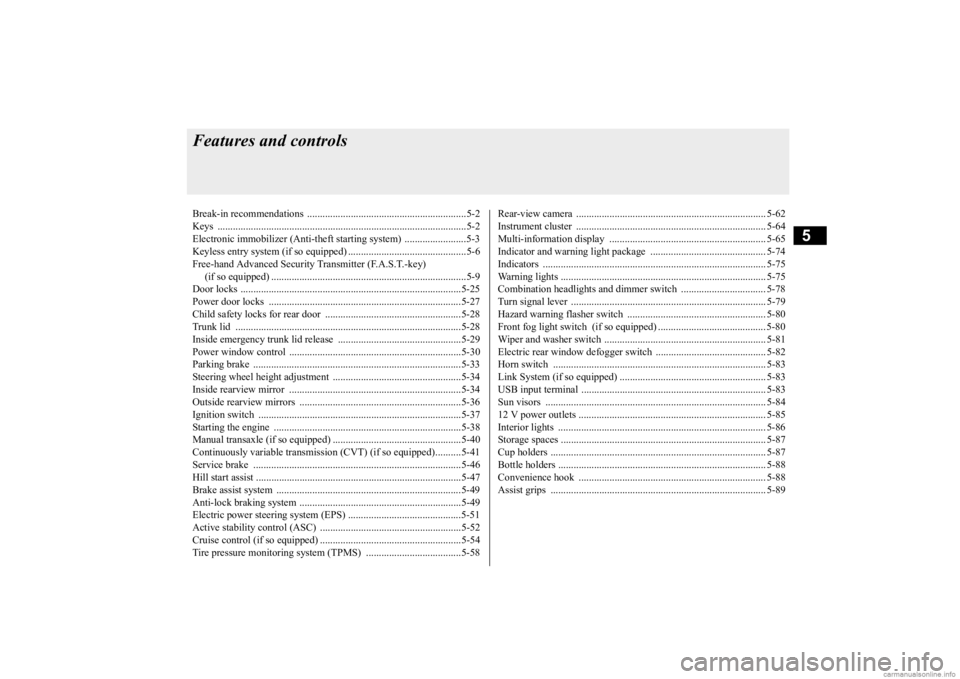
5
Features and controlsBreak-in recommendations ..............................................................5-2 Keys .................................................................................................5-2 Electronic immobilizer (Anti-theft starting system) ........................5-3Keyless entry system (if so equipped) ..............................................5-6 Free-hand Advanced Security
Transmitter (F.A.S.T.-key)
(if so equipped) ............................................................................5-9Door locks ......................................................................................5-25 Power door locks ......
...........
...........
...........
...........
...........
.........
.....5-27
Child safety locks for rear door ..........
...........
.........
.........
.........
.....5-28
Trunk lid ................
............
...........
...........
...........
...........
...........
.....5-28
Inside emergency trunk lid release ................................................5-29 Power window control ...................................................................5-30Parking brake .................................................................................5-33 Steering wheel height adjustment ..................................................5-34 Inside rearview mirror ...................................................................5-34Outside rearview mirrors ...............................................................5-36 Ignition switch ...............................................................................5-37 Starting the engine .........................................................................5-38Manual transaxle (if so equipped) ..................................................5-40 Continuously variable transmission
(CVT) (if so equipped)..........5-41
Service brake .................................................................................5-46Hill start assist ................................................................................5-47 Brake assist system ........................................................................5-49 Anti-lock braking system ...............................................................5-49Electric power steering system (EPS) ............................................5-51 Active stability control (ASC) .......................................................5-52 Cruise control (if so equipped) .......................................................5-54Tire pressure monitoring system (TPMS) .....................................5-58
Rear-view camera .......................................................................... 5-62 Instrument cluster .......................................................................... 5-64 Multi-information display ............................................................. 5-65Indicator and warning light package ............................................. 5-74 Indicators ....................................................................................... 5-75 Warning lights ................................................................................ 5-75Combination headlights and dimmer switch ................................. 5-78 Turn signal lever ............................................................................ 5-79 Hazard warning flasher switch ...................................................... 5-80Front fog light switch (if so equipped) .......................................... 5-80 Wiper and washer switch ............................................................... 5-81 Electric rear window defogger switch ....
...........
...........
...........
...... 5-82
Horn switch ................................................................................... 5-83 Link System (if so equipped) ......................................................... 5-83 USB input terminal ....
...........
...........
...........
...........
...........
............. 5-83
Sun visors ...................................................................................... 5-84 12 V power outlets ......................................................................... 5-85 Interior lights ................................................................................. 5-86Storage spaces ................................................................................ 5-87 Cup holders .................................................................................... 5-87 Bottle holders ................................................................................. 5-88Convenience hook ............
...........
...........
...........
...........
...........
...... 5-88
Assist grips .................................................................................... 5-89
BK0284300US.book 1 ページ 2019年5月23日 木曜日 午後12時22分
Page 76 of 253

Free-hand Advanced Securi
ty Transmitter (F.A.S.T.-key) (if so equipped)
Features and controls 5-11
5
N00503301093
The operating range is the interior of the vehicle.
N00503401430
While carrying the F.A.S.T.-key, press thedriver’s door lock/unlock switch (A) within the operating range to lock all the doors and trunk lid.The turn signal lights will blink once and the buzzer will sound once. Also refer to “Doors locks”, “Power door locks” and “Trunk lid” on pages 5-25, 5-27and 5-28 respectively.
*: Front of the vehicle : Operating rangeNOTE
Only the F.A.S.T.-key that is detectable by the doors and the trunk lid can lock and unlock the doors and open the trunk lid. The system may not operate if the F.A.S.T.- key is too close to th
e windshield, door win-
dows or trunk lid. Even if the F.A.S.T.-key is within about 2.3 feet (70 cm) of the driver’s door lock/unlockswitch or the trunk lid open switch, the sys- tem may not operate if the key is close to the ground or in a high position. If the F.A.S.T.-key is within the operating range, even a person not carrying theF.A.S.T.-key can lock and unlock the doors or open the trunk lid by pressing the driver’s door lock/unlock switch
or the trunk lid open
switch.
Operating range for starting the engine and changing the opera-tion mode
* : Front of the vehicle : Operating rangeNOTE
Even if the F.A.S.T.-key is within the operat- ing range, it may not be possible to start theengine and change the
operation mode if the
key is in a storage space such as the glove compartment, on top of the instrument panel,or in the door pocket or luggage compart- ment.
Even if the F.A.S.T.-key is inside the vehicle, it may not be possible to start the engine andchange the operation mode if the key is tooclose to a door or door window.
To operate using the F.A.S.T.- key
To l o c k
NOTE
BK0284300US.book 11 ページ 2019年5月23日 木曜日 午後12時22分
Page 81 of 253

Free-hand Advanced
Security Transmitter (F.A.S
.T.-key) (if so equipped)
5-16 Features and controls
5
N00559901184
When the operation mode is in OFF, the F.A.S.T.-key is left in the passenger compart-ment, all the doors are closed, and someone tries to lock the vehicle by pressing the driver’s door lock/unlock switch, the warninglight blinks and the bu
zzer sounds for about 3
seconds as a warning,
and the doors cannot be
locked.
N00560001185
When the operation mode is in OFF, andsomeone tries to lock the vehicle by pressingthe driver’s door lock/unlock switch while one of the doors is not fully closed, the warn- ing light blinks and
the buzzer sounds for
about 3 seconds as a warning, and the doors cannot be locked.
N00560101199
When the operation m
ode is in any mode
other than OFF, and someone tries to lock the vehicle by pressing the driver’s doorlock/unlock switch, th
e warning light blinks
and the buzzer sounds fo
r about 3 seconds as
a warning, and the doors cannot be locked.
N00514601357
The operation mode ca
n be in any mode
to start the engine. The starter motor will be turning for up to approximately 15 seconds if the engine switch is released at once. Pressing the engine switch again while the starter motor is still turning will stop the starter motor. The starter motor will be turningfor up to approximately 30 seconds while the engine swit
ch is pressed.
If the engine does not start, wait for awhile and then attempt to start the engine again. Trying repeatedly with the starter motor still turning will damage the startermechanism. If the engine will not start because the bat- tery is weak or discharged, refer to“Jump-starting the engine” on page 8-2 for instructions. A longer warm up period will only con- sume extra fuel. The engine is warmed up enough for driv- ing when the low coolant temperatureindicator goes out. Refer to “Low coolant temperature indi- cator” on page 5-75.
NOTE
The F.A.S.T.-key take
-out monitoring system
does not function if the F.A.S.T.-key isremoved through a window without openinga door. This setting can be changed. See an authorized Mi
tsubishi Motors dealer
for details. The warning may display even if the F.A.S.T.-key is in the operating range for starting the engine a
nd changing the opera-
tion mode. The surrounding environment orelectromagnetic waves
may make it impossi-
ble to verify the ID codes of the F.A.S.T.-key and vehicle.
Key lock-in prevention system
Door ajar prevention system
Operation mode OFF reminder system
Starting and stopping the engine
Tips for starting
BK0284300US.book 16 ページ 2019年5月23日 木曜日 午後12時22分
Page 82 of 253
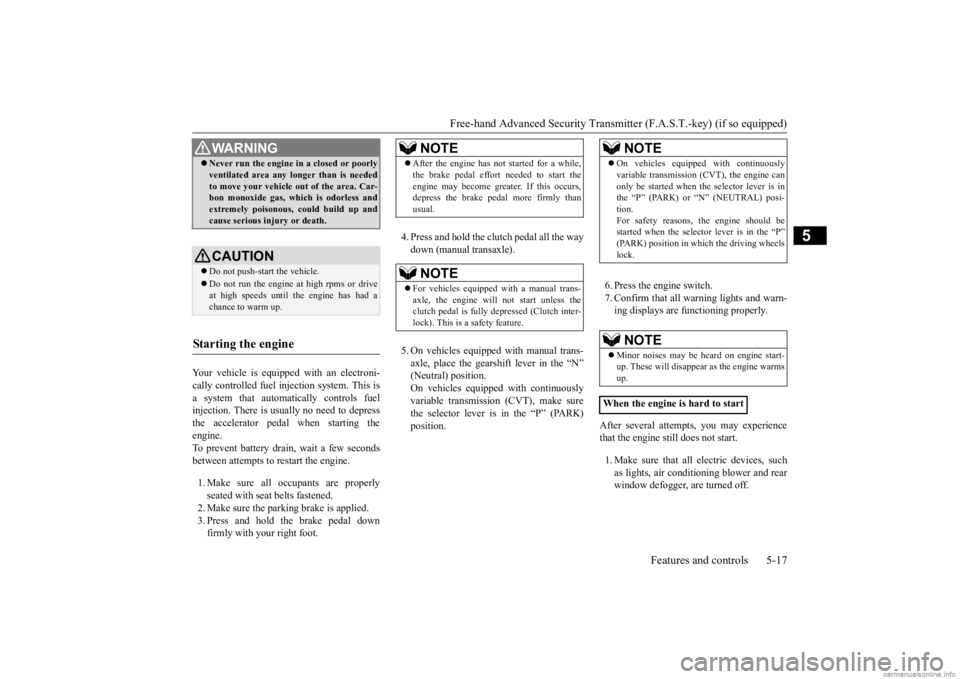
Free-hand Advanced Securi
ty Transmitter (F.A.S.T.-key) (if so equipped)
Features and controls 5-17
5
Your vehicle is equipped with an electroni- cally controlled fuel in
jection system. This is
a system that automatically controls fuelinjection. There is usually no need to depress the accelerator pedal when starting the engine.To prevent battery drai
n, wait a few seconds
between attempts to restart the engine. 1. Make sure all occupants are properly seated with seat belts fastened.2. Make sure the parking brake is applied. 3. Press and hold the brake pedal down firmly with your right foot.
4. Press and hold the clutch pedal all the way down (manual transaxle). 5. On vehicles equippe
d with manual trans-
axle, place the gearshift lever in the “N” (Neutral) position.On vehicles equipped with continuously variable transmission (CVT), make sure the selector lever is in the “P” (PARK)position.
6. Press the engine switch. 7. Confirm that all wa
rning lights and warn-
ing displays are functioning properly.
After several attempts, you may experience that the engine still does not start. 1. Make sure that all electric devices, such as lights, air conditio
ning blower and rear
window defogger, are turned off.
WA R N I N G Never run the engine in
a closed or poorly
ventilated area any lo
nger than is needed
to move your vehicle out of the area. Car-bon monoxide gas, whic
h is odorless and
extremely poisonous, could build up and cause serious injury or death.CAUTION Do not push-start the vehicle.Do not run the engine at high rpms or drive at high speeds until th
e engine has had a
chance to warm up.
Starting the engine
NOTE
After the engine has not
started for a while,
the brake pedal effort needed to start theengine may become grea
ter. If this occurs,
depress the brake pedal more firmly than usual.NOTE
For vehicles equipped with a manual trans- axle, the engine will
not start unless the
clutch pedal is fully
depressed (Clutch inter-
lock). This is a safety feature.
NOTE
On vehicles equippe
d with continuously
variable transmission (C
VT), the engine can
only be started when th
e selector lever is in
the “P” (PARK) or “N” (NEUTRAL) posi- tion. For safety reasons, the engine should bestarted when the selector lever is in the “P” (PARK) position in which the driving wheels lock.NOTE
Minor noises may be heard on engine start- up. These will disappear as the engine warms up.
When the engine is hard to start
BK0284300US.book 17 ページ 2019年5月23日 木曜日 午後12時22分
Page 95 of 253
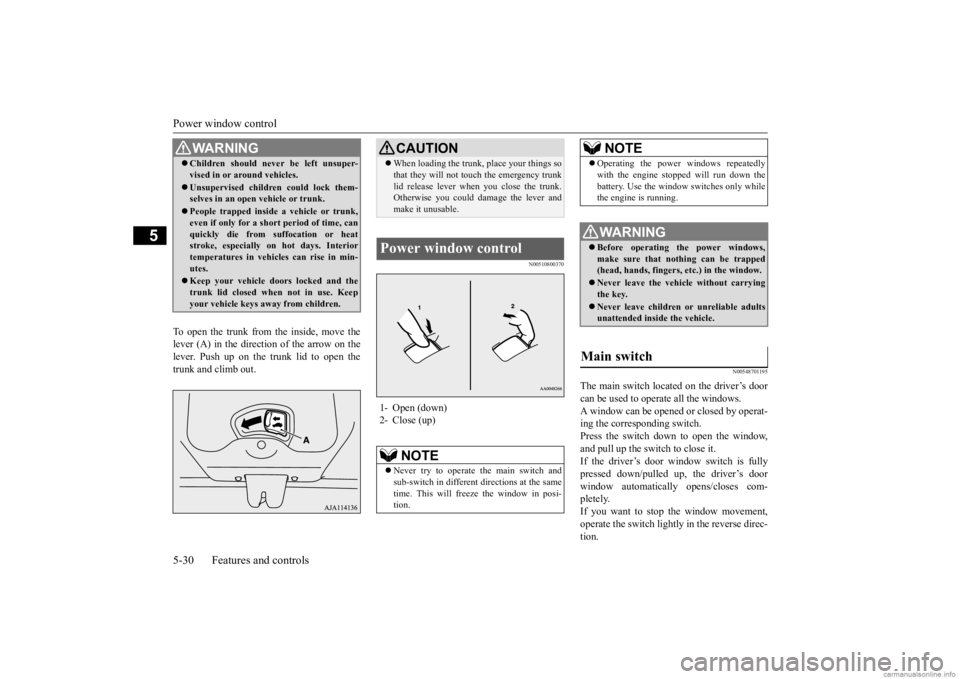
Power window control 5-30 Features and controls
5
To open the trunk from the inside, move the lever (A) in the direction of the arrow on thelever. Push up on the trunk lid to open the trunk and climb out.
N00510800370
N00548701195
The main switch located on the driver’s door can be used to operate all the windows. A window can be opened or closed by operat- ing the corresponding switch.Press the switch down to open the window, and pull up the switch to close it. If the driver’s door window switch is fullypressed down/pulled up, the driver’s door window automatically opens/closes com- pletely.If you want to stop the window movement, operate the switch lightly in the reverse direc- tion.
WA R N I N G Children should never be left unsuper- vised in or ar
ound vehicles.
Unsupervised children could lock them- selves in an open vehicle or trunk. People trapped inside a vehicle or trunk, even if only for a short period of time, can quickly die from su
ffocation or heat
stroke, especially on
hot days. Interior
temperatures in vehicles can rise in min- utes. Keep your vehicle d
oors locked and the
trunk lid closed when not in use. Keepyour vehicle keys away from children.
CAUTION When loading the trunk, place your things so that they will not touch the emergency trunklid release lever when you close the trunk.Otherwise you could da
mage the lever and
make it unusable.
Power window control 1- Open (down) 2- Close (up)
NOTE
Never try to operate the main switch and sub-switch in different directions at the sametime. This will free
ze the window in posi-
tion.
Operating the power windows repeatedly with the engine stopped will run down thebattery. Use the window
switches only while
the engine is running.WA R N I N G Before operating the power windows, make sure that nothing can be trapped (head, hands, fingers, etc.) in the window. Never leave the vehi
cle without carrying
the key. Never leave children
or unreliable adults
unattended inside the vehicle.
Main switch
NOTE
BK0284300US.book 30 ページ 2019年5月23日 木曜日 午後12時22分